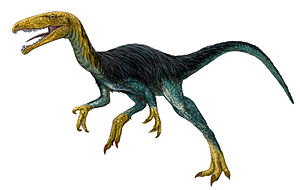Velocisaurus
| Velocisaurus | ||||||||||||
|---|---|---|---|---|---|---|---|---|---|---|---|---|

Graphic representation of Velocisaurus (based largely on Masiakasaurus and Noasaurus ) |
||||||||||||
| Temporal occurrence | ||||||||||||
| Upper Cretaceous ( Coniacium ) | ||||||||||||
| 89.7 to 86.3 million years | ||||||||||||
| Systematics | ||||||||||||
|
||||||||||||
| Scientific name | ||||||||||||
| Velocisaurus | ||||||||||||
| Bonaparte , 1991 | ||||||||||||
| Art | ||||||||||||
|
Velocisaurus is a genus theropod dinosaur that is assigned to the Noasauridae , a group of Ceratosauria . So far, only an incomplete hind leg is known, which comes from the Upper Cretaceous ( Coniacium ) Argentina . The only species is Velocisaurus unicus .
description
The only find is poorly preserved and consists of the lower part of the right hind leg. As with other Ceratosauria, the metatarsal bones show an " antarctometatarsal " arrangement: the third (i.e. middle of the three large) metatarsal bones take up more space in the upper part of the metatarsal than the second and fourth metatarsal bones. The second metatarsal is significantly reduced in size - a feature that can also be found in the related genera Noasaurus and Masiakasaurus . Although no autapomorphies are known - unique features that can be used to distinguish the genus from all related genera. However, due to its isolated occurrence, it is probably a separate genus.
History of discovery and naming
The incomplete hind leg was discovered in 1985 by Oscar de Ferrariis and Zulma Gasparini in the layers of the Bajo-de-la-Carpa Formation in the Argentine province of Neuquén . In 1991 , José Fernando Bonaparte described the fossils as Velocisaurus unicus . The generic name is derived from velox ("fast"), as an indication of the animal's light physique, and sauros ("lizard"). The species name unicus means "unique", which should indicate the unique construction of the foot.
The only find and holotype is kept under copy number MUCPv-41 in the collection of the Museo de la Universidad Nacional del Comahue .
Systematics
Originally, Bonaparte introduced Velocisaurus to a new family, the Velocisauridae. A 2003 study by Fernando Novas and Sebastian Apesteguia showed that Velocisaurus was a close relative of Masiakasaurus . Both genera were also grouped together as Velocisaurinae. In 2004 Velocisaurus and Masiakasaurus were assigned to the group Noasauridae .
Individual evidence
- ^ A b Matthew T. Carrano, Scott D. Sampson: The Phylogeny of Ceratosauria (Dinosauria: Theropoda). In: Journal of Systematic Palaeontology. Vol. 6, No. 2, 2008, ISSN 1477-2019 , pp. 183-236, doi : 10.1017 / S1477201907002246 .
- ↑ Ben Creisler: Dinosauria Translation and Pronunciation Guide ( Memento of October 13, 2011 in the Internet Archive )
- ↑ a b José F. Bonaparte : Los vertebrados fósiles de la Formación Rio Colorado, de la Ciudad de Neuquén y Cercanías, Cretácico Superior, Argentina. In: Revista del Museo Argentino de Ciencias Naturales Bernardino Rivadavia e Instituto Nacional de Investigación de las Ciencias Naturales. Paleontología. Vol. 4, No. 3, 1991, ISSN 0524-9511 , pp. 17-123.
- ↑ Federico L. Agnolin, Fernando E. Novas , Sebastián Apesteguía: Velocisaurids in South America and Madagascar. In: Ameghiniana. Vol. 40, No. 4, Supplement, p. 77R.
- ↑ Fernando E. Novas, Federico L. Agnolin, Saswati Bandyopadhyay: Cretaceous theropods from India: A review of specimens described by Huene and Matley (1933). In: Revista del Museo Argentino de Ciencias Naturales. NS Vol. 6, No. 1, 2004, ISSN 1514-5158 , pp. 67-103, digitized version (PDF; 78.62 KB) ( Memento of the original from October 7, 2012 in the Internet Archive ) Info: The archive link became automatic used and not yet tested. Please check the original and archive link according to the instructions and then remove this notice. .